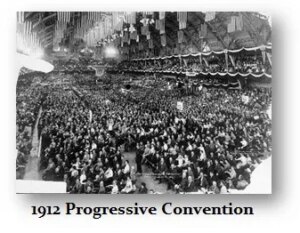The Rise of Fragmentation: A Look at Political Divides in Canada and Beyond
As the curtain rises on the 21st century, we are witnessing an unprecedented wave of political polarization that resonates across borders—from Canada to the United States and into Europe. At the heart of this phenomenon is a significant divide that echoes a tumultuous chapter in history, hinting at potential shifts in the socio-political landscape. Here at the Extreme Investor Network, we believe understanding these dynamics is crucial for investors and citizens alike, as they influence not only policy but markets as well.
A Historical Perspective: Echoes of the Progressive Era
To truly grasp the current political climate, it’s essential to look back to the early 20th century. The political fragmentation we observe today can be likened to the ideological battles that defined the early 1900s in the United States, particularly during the Progressive Era. In 1912, a pivotal moment occurred when Theodore Roosevelt, dissatisfied with the conservative policies of President William Howard Taft, broke away from the Republican Party to establish the Progressive Party, famously known as the Bull Moose Party.
This schism was not just about personal grievances; it reflected a broader public yearning for economic fairness and increased governmental accountability. Roosevelt’s platform, dubbed “New Nationalism”, championed causes such as:
- Robust federal regulations on corporations and monopolies
- Women’s suffrage
- Workers’ rights, advocating for minimum wage and workers’ compensation
- Direct election of senators to curb political corruption
- Social welfare programs, including pensions and child labor laws
His efforts underscored a collective push for reform during a time when the American electorate was yearning for change—a sentiment that bears striking resemblance to current calls for reform in Canada and beyond.
The Current Landscape: A Parable of Polarization
Fast forward to today, and we observe similar currents emerging in Canada. The nation, like many around the globe, is grappling with profound political divides. This fragmentation has reached a critical tipping point, highlighted recently by prominent figures like former Canadian central banker Mark Carney, who articulate concerns about the unity of political parties as they venture further leftward.
The tension between left and right politics is reminiscent of the ideological split that saw the rise of the Progressive Party over a century ago. We’re not just experiencing a divisive conversation; we’re entering an era that may reshape the dialogue surrounding governance in Canada. Just as Roosevelt’s campaigns shifted discourse and prompted lasting reforms despite electoral defeat, modern political movements today echo that spirit of transformation.
Lessons for Investors: Navigating a Fragmented Future
Why should investors care about this growing divide? Political polarization doesn’t just shape policies; it can also impact market stability and investment trajectories. The similarities between historical and current events present unique opportunities and risks for investors. As we see calls for significant reforms—be it in taxation, corporate regulations, or workers’ rights—these shifts could dramatically alter the economic landscape, opening avenues for savvy investors.
At Extreme Investor Network, we emphasize that understanding the sociopolitical environment is vital for strategic investment decisions. The historical context reveals that market adaptability is crucial when navigating through politically charged atmospheres. Investors should remain alert, as the abandonment of centrist ideologies could lead to increased volatility—offering both opportunities and threats.
Conclusion: A Call to Engagement
As we reflect on the past and examine the present, it becomes increasingly apparent that the lessons from history are not just academic; they are deeply relevant. Engaging with the political narratives unfolding in Canada, the United States, and Europe is critical for any stakeholder in the economic landscape.
At Extreme Investor Network, we invite our readers to stay informed and proactive as we explore these pressing issues. Understanding the implications of political unrest and potential reforms will help you make informed investment decisions and prepare for the future. The trend towards polarization does not merely represent a political crisis—it presents an opportunity for transformation, resilience, and ultimately, informed investing.
Stay tuned with us for upcoming insights that will unravel the complexities of economics in a politically divided world.

